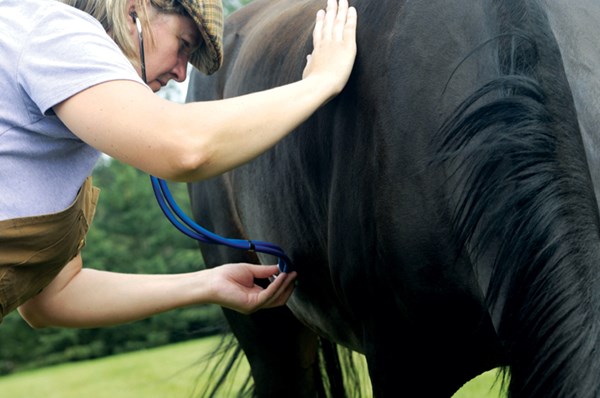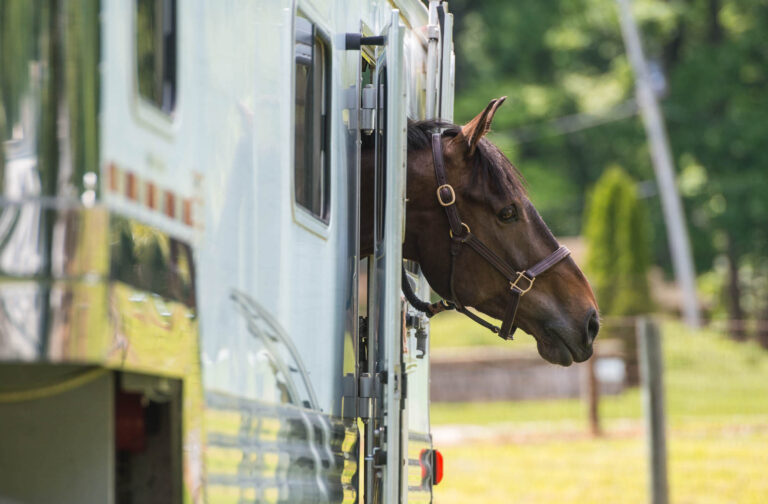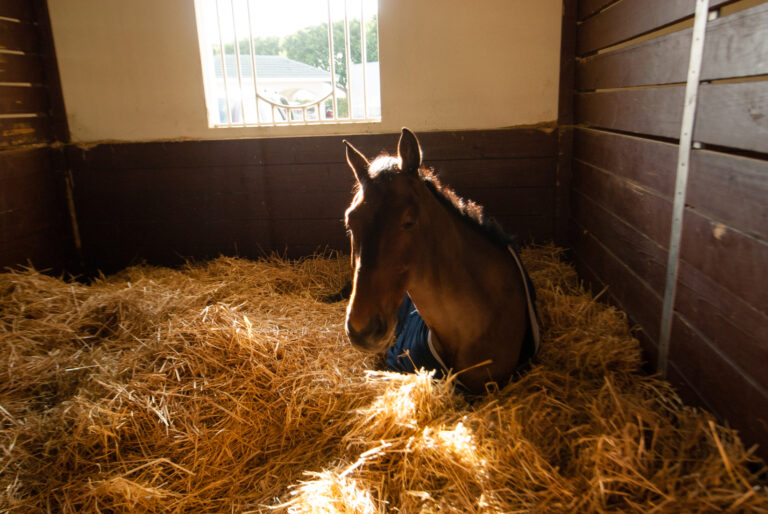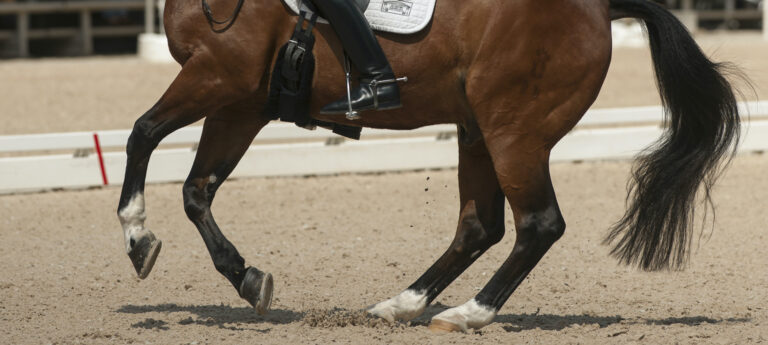It’s 9 p.m. and time for your final check of the barn before turning in. In addition to the soothing, muffled noise of horses contentedly munching on hay, you hear something more: a pawing, then a kick at the wall. You find your 18-year-old gelding sweating despite the mild temperature in the barn. He is repeatedly turning to look at his flank and has a distressed look in his eyes. Checking the feed bucket, you see there are still pellets from his evening meal. Immediately, you think: colic!

Colic is a word that strikes fear in horsemen everywhere—and with good reason. Colic is the most common equine ailment necessitating emergency treatment and is often considered the single largest killer of horses.
There are many types of colic. Broadly speaking, the causes can be classified as simple obstruction, strangulating obstruction and inflammatory disease.
Simple obstructions block the normal flow of food ingested without significant compromise of blood flow to the affected intestine, explains Rolf M. Embertson, DVM, DACVS, and one of the owners of Rood and Riddle Equine Hospital in Lexington, Kentucky. Impactions and displacements are simple obstructions and are generally associated with mild to moderate signs of colic.
Strangulating obstructions occur when the flow of intestinal contents and the blood supply is obstructed. These colics result in more severe symptoms and are much more serious.
Inflammatory diseases can affect the small intestine (enteritis) or colon (colitis or diarrhea) and appear much like a classic colic. They are often accompanied by fever, dull mentation, decreased appetite, bright red mucous membranes and a decrease in circulating white-blood-cell count.
What Causes Colic?
This is the $64,000 question. The cause of colic in most cases remains undetermined. “For colicky horses successfully treated medically, the cause of the abdominal pain may never be definitively determined,” says Dr. Embertson. “For horses needing surgery to resolve the colic, the abnormality causing the abdominal pain is identified and corrected. However, the actual reason that the abnormality occurred is still often undetermined.” Research is ongoing to identify the variety of factors that seem to be associated with horses developing colic.
Poor-quality feed, change in diet or level of activity, minimal turnout or forage in the diet and excessive parasite burden may all play a role in a horse’s predisposition to colic. Specific causes of colic are recognized in certain groups of horses. For example, strangulating pedunculated lipoma is observed in older horses, and a twist in the large colon or uterus is a common cause of abdominal pain in broodmares.
A horse’s environment or geographic location may also predispose him to certain types of colic. A horse is more likely to develop sand colic if he lives in a sandy soil environment. The development of stones in the intestines is more prevalent on the West coast, and ileal impaction—associated with feeding Coastal Bermuda grass hay—is more common in the southeast.
Supplements are available that are said to help minimize the risk, including psyllium—a plant-derived dietary fiber used to promote regularity in bowel movement and touted recently for its ability to decrease the likelihood of sand colic in horses. “There are studies that conclude that the use of psyllium is beneficial in clearing sand from the GI tract,” says Louise Southwood, BVSc, PhD, DACVS, DACVECC, an associate professor at Penn Vet’s New Bolton Center in Pennsylvania. “And there are other studies that indicate it is not.” There is also no evidence indicating that psyllium is harmful. At the very least, “It is quality fiber that is probably good for the health of the intestines.”
Signs of Colic
The signs of colic “can be as subtle as more frequent or prolonged periods of lying down or loss of interest in food,” says Dr. Southwood. While these signs can be indications of many problems, they are more associated with colic when the horse is also watching his flank, pawing, kicking at his abdomen, stretching as if trying to urinate, lying down and rolling or thrashing. These signs are specific for colic. You might also notice less manure in the stall.
“Know your horse,” says Barbara Dallap Schaer, VMD, DACVS, DACVECC. She is also an associate professor at New Bolton Center. “Observing even subtle behavior changes in your horse may alert you to the fact that he has some source of pain.”
Colic Treatment
The first step toward a positive outcome is recognizing the signs of colic and that your horse is in pain, explains Dr. Embertson. It is important to remember that horses have variable tolerance for pain. Older horses and draft horses in particular will be slower to let you know when it hurts.
If you find your horse in discomfort, be sure to scoop up any leftover feed, take hay out of the stall and call your vet, who may recommend giving an oral non-steroidal anti-inflammatory drug, such as Banamine®.
Keep a written record of when the horse first showed signs of possible colic, how severe those signs were and how much medication was given and when. This will be valuable to your vet at the initial assessment. Hand-walking your horse can sometimes help with gas or impaction colic. Occasionally, a horse with colic will roll violently, and it is important to have him in a safe place to minimize injury.
Once the vet arrives, he or she will do a physical examination. Fortunately, the majority of horses with colic—80 to 90 percent—can be managed medically at home with pain medication as well as oral lubricants, laxatives and fluids. However, your vet may advise you not to give more medication and to trailer your horse to the nearest emergency clinic as quickly as possible.
Taking Your Horse to the ER
Preparing a horse for transfer to a veterinary facility depends on his level of pain and the referring vet’s diagnosis, according to Dr. Southwood. The referring vet can administer short-term pain medication as he or she deems necessary. If the vet has placed a tube through the horse’s nose into the stomach and liquidy reflux is produced through the tube, or if the vet detects small intestinal swelling when feeling the horse’s abdomen through the rectum, the horse should be checked for reflux immediately prior to shipping and the tube left in place and secured for the trip. The veterinarian will determine if administration of IV fluids is necessary. When trailering a horse suffering from colic, it’s best to remove the dividers from your trailer in case he lies down, and once he is loaded, leave his head loosely tied.
As you arrive at the clinic, a nursing assistant will be called to admit the horse. After a brief introduction, the attending veterinarian will begin a complete physical exam. A nurse will take your horse’s temperature while the vet listens to his heart, lungs and intestinal sounds with a stethoscope.
You will be asked about medications that have already been administered, the last time the horse ate, how long he has been showing signs and whether this is his first potential colic episode. Blood will be drawn for analysis, and a catheter will be placed in the vein to allow quick access for delivering medications and fluids. The veterinarian may also do a rectal exam to feel for abnormalities in your horse’s abdomen. He or she may also tube your horse again to check for reflux.
To Operate or Not
Dr. Southwood explains that when surgery or more medical treatment is required, horses that are treated early have a higher survival rate and fewer complications. A horse already at an emergency clinic has more rapid access to surgical facilities and an experienced surgical team. The decision to take a horse with colic to surgery is based primarily on persistent abdominal pain that is not improving with pain medication.
“Many factors play a role in the decision,” says Dr. Embertson. “These include the findings of rectal and ultrasound exams, response to removing gas and liquid from the stomach with a stomach tube, walking, administration of fluids, analysis of blood and abdominal fluids, and heart and respiratory rates.”
In certain cases, such as strangulating obstructions, surgery is the only option for survival, and the earlier the better. “Without surgery,” says Dr. Southwood, “these horses would require euthanasia or die a painful death.”
Postsurgery Prognosis
The good news is that the prognosis for survival of horses with colic has improved over the past 15 to 20 years. According to Dr. Southwood, “Early referral and surgical intervention have been key and probably the most important factors contributing to the marked improvement of horses that do require surgery.”
“The results of a body of research,” adds Dr. Embertson, “have improved our understanding of colic and our ability to successfully treat affected horses. Many surgical techniques have been used for years, but research is always offering ways to refine them.”
Surgical advances have helped improve survival rates and rate of return to function. According to Dr. Embertson, laparoscopic surgery, which requires a very small incision, has been useful to prevent some conditions that can cause recurrent colic. “However, for emergency abdominal surgery, manually working through an incision into the abdomen is still the best approach to prompt resolution of the problem.”
In those cases where surgery is indicated, it need not be considered the option of last resort. Prompt transport to referral surgical hospitals rather than prolonged treatment prior to referral, along with surgery performed without delay, are two key reasons for improved outcomes, says Dr. Embertson. In one study, he and coworkers reported a survival rate of 83 percent in horses with a large colon twist. This compared favorably to a 25-percent rate in previous reports. The team credited early surgical intervention with the highly improved success rate.
With conditions causing strangulation of the small intestine, surgery within three hours of when the colic started often allows correction of the problem without resection of the affected part of the intestine. And where age was once a limiting factor, two recent studies at the New Bolton Center have shown that it is not significant in determining the outcome of colic surgery. Older horses and young foals have both been found to show comparable survival rates to their younger and older counterparts, respectively.
Medical-management advances have also played a role in the success of colic treatments. Identifying drugs that minimize adhesions formed during surgery and those that help the intestines return to normal function after surgery have contributed to improving outcomes. The threat of shock for horses with colic has also been minimized through better understanding of supportive therapies and more sophisticated application of them.
Adds Dr. Southwood, “Advances have also been made with regard to quantification of pain and the most effective ways to manage it, both in the hospital and during surgery. Our horses also benefit from research that has led us to more careful monitoring techniques.”
After Successful Surgery
Post-operative therapy often includes administration of antimicrobial and anti-inflammatory/analgesic drugs, intravenous fluid and nutritional support, if necessary. “The goal is for the horse to return to a good plane of nutrition and the intended use as quickly as possible,” says Dr. Embertson. “To reach this goal, early recognition and prompt resolution of the colic episode are very important. This also contributes to less postoperative care, shorter hospitalization and lower medical costs.”
Following discharge, horses are typically stall-confined for one month with hand-walking and turned out in a small paddock for a second month, after which they might be moved into a larger field for a month and gradually returned to their exercise routine. Owners should carefully monitor the horse’s surgical incision, appetite, attitude and manure production in the immediate postoperative period. Any concerns should be directed to their veterinarian or the surgeon.
Abdominal pain, from all its many causes, will, unfortunately, remain a fact of life for horses and their caregivers at least for the foreseeable future. “Even with the improvements gained from the results of research,” concludes Embertson, “the most important factor affecting the outcome of colicky horses is minimizing the duration of the colic episode.”
Know the predisposing factors that you can control and eliminate them. Remain observant of your horse’s comfort and, most importantly, act quickly should you suspect colic. These will all work in your horse’s favor.











